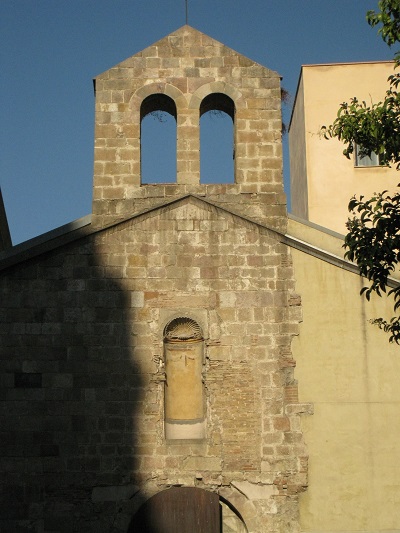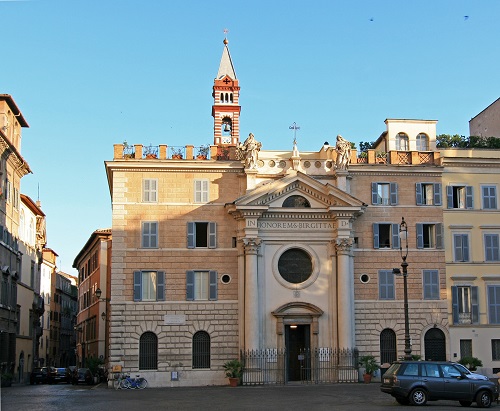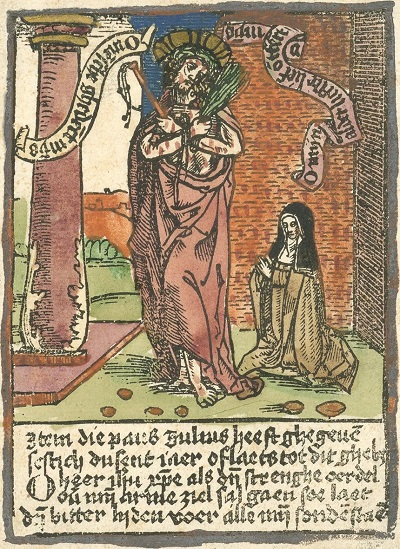Chapel of Sant Llàtzer. Photo: Enfo. (Creative Commons Attribution-Share Alike 3.0 License)
There is a famous scene in The Book of Margery Kempe in which Margery meets with a woman described in the text as a “Senyt Brydis mayden” [St. Birgitta’s maidservant]. Devotion to and imitation of Birgitta of Sweden is one of the key features of Margery’s spirituality. Earlier in the Book it is related that someone read to Margery from The Revelations of Birgitta, or Bride as she is often called in English. It seems not surprising then that in her sojourn in Rome Margery seeks out the testimony of those who knew Birgitta, and it is no coincidence than a cluster of visits to places connected with Birgitta follows this episode. This is one of the occasions in which The Book of Margery Kempe traces connections with places and people who can be verified through history; it is one of those moments when the historicity of The Book flares up, if only fleetingly.
But let’s go back for a moment to the account of that encounter with the maidservant. Margery only knows Bridget, or Birgitta, indirectly, from religious texts and from her reflection in the devotional culture of the 15th century. As well as The Revelations, she is in all likelihood familiar with the Vitae which circulated along with her texts or as part of offices for her commemoration. The Book records that Margery cannot understand the maidservant, but the language she speaks is not recorded. However it seems reasonable to assume that it is Italian, as Margery is able to find someone to translate for her. Margery asks “aftyr Senyt Brigypt” [after Saint Birgitta] and she is told that she was “goodly and meke to every creatur, and that sche had a lawhyng cher” [was kind of meek to every creature, and that she had a laughing face]. There are several things going on during this exchange, which I will come back later, but for now it is interesting to note that the information extracted by Margery from the so-called maidservant is not found in any other written source; it is a personal memory.
There are nevertheless several descriptions of Birgitta’s household in the sources. In The Book of Margery Kempe the word “mayden” is probably misleading. Admittedly the hagiographic tradition tells that she used to have honest women in her service. However the best source, the canonization proceedings, describes two Spanish anchoresses who travelled with her to Jerusalem and who lived with her in Rome. Their names are Praxedis and Elvira. They are represented, during their depositions, as “habitatrix in loco heremitacionis” [dwelling at a hermitage] and the terms “soror” [sister] and “paupercula” [poor] are applied to them. They are then not necessarily enclosed in a monastery, but they are devout recluses rather than maidservants. Birgitta obviously could have had maidservants, but a cautionary note needs to be issued here about how these women, living together, ended up being perceived after at least one of Birgitta’s female associates gained popularity and fame. These women were probably part of a greater following, dispersed in different locations (in their case in Spoleto) after Birgitta’s death.
There is a beguine in Barcelona who may have been part of that following, and if the sources are to be believed, an important member. Her name is Sor Sança (Sister Sança), and some documents have survived that tell us about her. Elena Botinas i Montero, along with Julia Cabaleiro i Manzanedo and M. dels Àngels Duran i Vinyeta have tracked her down in the documents, referring to her as Franciscan tertiary, beguine, and, crucially for our purposes, companion to Saint Birgitta in Rome. I am going to focus only on the documents that refer to her as the latter, since Sança was not an uncommon name, and it is uncertain to what extent they are the same person, even if the scholars mentioned here believe them to be.
The first document I want to comment on is held at the Archives of the Crown of Aragon (ACA R. 2350). It is a letter that Queen Maria de Luna addresses to the mestre racional or the treasurer of the Crown of Aragon (I apologise for simplifying this definition which is somewhat more complex), stating the following:
(…) a beguine who was in Barcelona close to the Church of Santa Margarida, she had with her while she lived different things that had been used by the person of Santa Brígida and specially the cilice [spiked garter], the disciplines, and the strap, and her being dead, which was not so long ago, you or Sor Teresa, beguine, who helped the said recluse, took in custody the said things and you still have them (the transcription of the document can be checked here)
The queen, Maria Luna, might well have known about Birgitta given the connections of the Crown of Aragon with Naples. She here requests the devotional objects, this is to say relics, left behind by Sor Sança. However Birgitta of Sweden is not Dorothea von Montau, and we have no other evidence that her devotional exercises included self-mortification. Nevertheless The Revelations, for example, comment that caution was recommended to her in practices such as fasting, and we might infer from this that she may have used similar objects to the ones described, even if they were not mentioned in main sources.
The second document I want to comment actually names the beguine as Sor Sança and it sheds more light on the location and nature of her dwelling located near the Church of Santa Margarida. The document can be consulted here. It is a petition from Sor Brigida or Brígida Terrera on behalf of a community of women living in a “resclusatge” or a hermitage. This group of anchoresses lived together following the mixed life, both contemplative and active, in this case taking care of the sick. The church – still standing- was probably the one of the Hospital of Santa Margarida del los Messells o Sant Llàtzer, devoted to the care of leprosy patients. The petition dated to 1448 asks the authorities of the city of Barcelona to assume responsibility for the hermitage.
Casa di Brigida. Photo: Enfo (public domain image)
The petition records that this dwelling had its origins a hundred years earlier when a man built it for his daughter so that she could enclose herself within it. It is not clear whether at the point when it was first established the dwelling was an anchorhold attached to that church or a house donated by the father. Sor Brigida explains that when the young woman died, the dwelling was occupied by Sor Sança, in all likelihood the same woman who was Birgitta’s companion in Rome. The dwelling subsequently housed a larger group of women, who found themselves under pressure, like any other community of religious women or men living without a rule, to get institutional approval. Interestingly, the community finally adopted the rule of the Hieronymite Order, founded by the brother of Birgitta’s confessor Alfonso of Jaén, and they moved and occupied an old building nearby.
Sor Sança, Praexdis and Elvira, all companions of Birgitta in Rome, made similar moves after Birgitta’s death: all three of them became anchoresses and lived in hermitages. But the case of Sor Sança is interesting because of her connection to the scene in The Book of Margery Kempe discussed earlier. Both the mysterious maidservant and Sor Sança become living transmitters of the memory of Saint Birgitta: they are, in a sense, living memory boxes, but they also carry memory boxes in the form of relics (in the case of Sor Sança those that Queen Maria Luna is so keen to appropriate for herself). I borrow here the term memory box as understood by Aleida Assmann who defines memory boxes as “objects in which important documents are preserved”. I would add that individuals can also function as memory boxes, in that they can be moved, they can meet another people, and they can change them.
Man of Sorrows and Saint Bridget. Woodcut, hand coloured. 116 × 85 mm. Amsterdam, Rijksmuseum Amsterdam inv.no. RP-P-1908-1937 (public domain image)
It has been often stated that the reception of Birgitta in the Iberian Kingdoms never happened. This idea comes, doubtless, from the insistence of measuring reception in terms of the transmission and translation of texts. What I have just described is a perfect example of cultural transfer, cultural interaction or cultural translation. Both Sor Sança and Sor Birgida embody the remembrance of Birgitta, or what she means at the time the memory box is opened, illustrating some of the complex and non-textual ways that devotions and beliefs can travel, influence and transform.
David Carrillo-Rangel
University of Barcelona, Spain
Twitter: @davidcrangel



